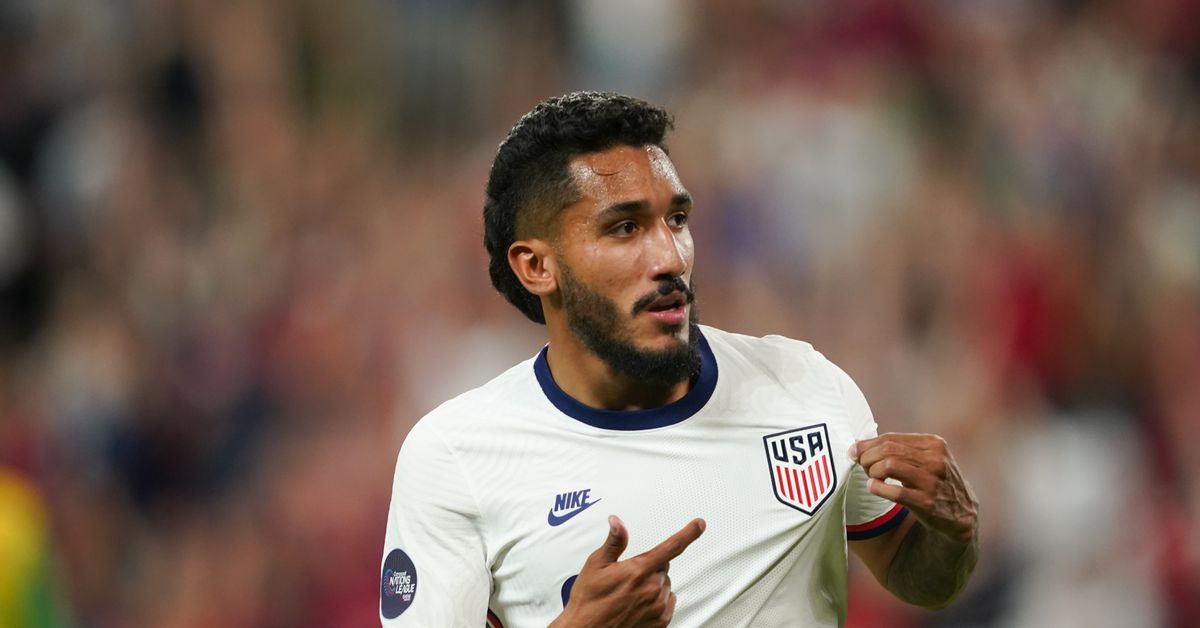The USMNT took on an overmatched Grenada team to open up the group stage of the 2022-23 CONCACAF Nations League and walked out with a 5-0 win.
What did we learn? Goals are fun, I guess.
Look, Grenada don’t match up well to the USMNT. The US is going to the World Cup as one of the higher ranked teams (currently ranked 15th in the world), while Grenada don’t even make top 15 in North America (they are 24th in CONCACAF, 170th in the world). It’s a small Caribbean nation with a team made up mostly of players from lower league and semi-professional clubs from Grenada, the US, and England. It’s a total mismatch.
So instead of trying to be comprehensive about the match, let’s just hit some big points. It’s been a while since I did one of these, but let’s do a Stock Up/Stock Down:
Stock Up
Jesus Ferreira
Watching through most of the first half, it was starting to feel like I’d have to say something about Jesus Ferreira’s lack of finishing. Against Morocco and Uruguay, Ferreira got chances, really good chances, but failed to actually score them. The first half mostly felt like a continuation of that trend. But then, he scored at the end of the half, picking up a mis-placed ball before and cutting a few steps in before slotting cooly into the bottom far corner. And then the dam burst. Four goals on the night! FOUR!!!! After that kind of performance, Ferreira deserves a good word.
The thing holding Ferreira back from totally claiming the starting striker spot was a lack of finishing. That number 9 spot was wide open because all the other options weren’t able to hit their stride and make it theirs: Ricardo Pepi’s fallen into a months-long goal-scoring draught at both the club and international levels. Daryl Dike needed to work on his touch and combination game even before he got hurt. Gyasi Zardes lost his starting spot with the Columbus Crew before being traded. Josh Sargent basically became a non-scoring defensive winger for Norwich in their Premier League relegation campaign. And, while Jordan Pefok could bag goals by the dozen in the Swiss league, his lack of combination ability made him a poor fit for the USMNT (even before missing an absolute sitter in the away game v. Mexico). There are a few options in MLS who could contest the spot (specifically, Brandon Vazquez and Jeremy Ebobisse), but they’ve yet to actually be tested at the international level since hitting a hot patch of form.
To his credit, Ferreira’s looked the closest to taking that starting spot. Quite obviously, Berhalter likes him, but the FC Dallas striker has been scoring goals in MLS, with a spot at the top of the Golden Boot race to prove it. And with the national team, he’s at least been consistently finding dangerous pockets and chances, which is more than can be said about the other options. The problem had been finishing. And, well, this time, he finished.
Look, all the caveats apply to this one. This was Grenada. Just because he did here doesn’t mean he’s going to be able to do it when the US has to play v. Wales and England and Iran in the World Cup. But, again, the problem wasn’t that Ferreira wasn’t scoring because of a lack of chances of shots. It was a lack of finishing. Finishing is more likely to carry over than other skills because it doesn’t depend as much on the ability of the competition. In any case, hopefully this is a sign of things to come because the US could really use a proper goal-scoring striker up top.
Luca de la Torre
Quite frankly, the USMNT looked pretty stale in the first half. They had no trouble controlling the ball in Grenada’s half, even consistency playing in the final third. But they weren’t creating many dangerous chances or even getting into particularly dangerous spots as often as you would hope against such outmatched opposition. However, when the US were able to advance up the field, it was usually through Luca de la Torre. de la Torre was a huge link for the US between midfield and the offensive line, generating a huge number of chances on the night. The chart below shows the average position of players and who they passed to, with thicker lines indicating more passes between two players.
:no_upscale()/cdn.vox-cdn.com/uploads/chorus_asset/file/23621253/Screen_Shot_2022_06_11_at_10.20.30_AM.png)
de la Torre (number 14) has strong lines with loads of players, particularly Cameron Carter-Vickers (20), Kellyn Acosta (23), and Paul Arriola (7). Compared to other players, de la Torre also had a relatively strong link with Jesus Ferreira. All together, this demonstrates a player who’s instrumental to progressing the ball. And that was frankly easy to see on the field itself. For his troubles, de la Torre managed to register an assist.
Kellyn Acosta
It would be wrong of me to mention de la Torre’s ball progression without also mentioning Kellyn Acosta. Acosta rotated into the defensive midfield spot to give Tyler Adams a break and, while he didn’t have much to do on the defensive front, he did move the ball into the attack a lot. Look at that pass network from above; while the connection between Acosta (23) and Arriola is not quite as strong as de la Torre’s, it’s still a pretty strong line. And the line between Acosta and Ferreira (9) is even stronger than de la Torre! Given all that, it’s not surprising that Acosta wound up with an assist on the night.
Paul Arriola
Score a goal and register an assist and your stock will go up at least a little bit. I will say, that was quite a pretty finish there, too.
Stock Down
CONCACAF Nations League Format
Quite frankly, there’s not much point to having the United States play Grenada in the Nations League. Grenada gets a nice payday and the Grenadian players get to see top level players in action, along with the nice facilities in the US. But that’s it. There’s no real competitive benefit to seeing a semi-pro side getting thrashed by a top competitive one. It’s just too lopsided. Unfortunately, this is something inherent to the Nations League format.
With 4 groups of 3, you need a minimum of 12 teams for the League A group stage. And at 12 teams deep, you are already stretching things thin. While teams like Guatemala and Haiti can put up a semblance of competition, that’s about the extent that CONCACAF can go. But the promotion/relegation format pushes the bottom further down by kicking out the bottom teams from each group to League B, while promoting League B teams. And that’s how we get teams like Grenada in the top level of competition. The better teams are kicked out and replaced with worse ones.
Admittedly, Grenada is easily the weakest team in the competition. But it’s not like things would be all that different if the US had to play Martinique or Suriname. The one possible exception from the promoted teams is Curaçao, but the US isn’t even going to play them. In any case, the point stands; this is an unhelpfully lopsided competition.
The timing frankly makes things worse. Normally, players get the chance to be with their national teams for at least a few weeks before the World Cup, allowing time for a final set of friendlies to prepare. But, because this year’s World Cup in Qatar will be played in November and December, the European based players (the bulk of the squad and nearly all the starters) won’t be available early enough to schedule matches (the English Premier League plans to play the week before the World Cup starts). That makes these few remaining opportunities for matches all the more important. All told, between the start of June and the kick off of the World Cup, there’s only 6 realistic opportunities for matches, spread out across almost six months. That’s precious time. That’s precious time that CONCACAF is forcing the USMNT to waste by scheduling the US against Grenada.
In a normal schedule, one with a summer World Cup, these Nations League games would be coming after the World Cup. And, given that the entire world’s known about the timing of the World Cup for the last seven years, CONCACAF had enough time to figure out a way to make such a schedule work with a winter World Cup. It’s not hard to imagine alternatives. Simply delay the Nations League Final from the summer of 2023 to September and you have time to play these two extra matches without inventing FIFA dates or substantially messing with the broader schedule. It’s not that hard. And it’s a shame that CONCACAF didn’t put any effort into giving the countries going to the World Cup consideration in the scheduling.
Gregg Berhalter
You may have thought that Gregg Berhalter had a decent night, given that his team scored 5 goals. But, I’ll tell you what, you are missing something. Look, at this! It’s a total debacle! It just is not acceptable!
Look, you do not bounce pass to the opposition. You just don’t. It’s unbecoming of a supposed head-coach! Just thoroughly disgraceful towards the US players, fans, and staff. Undermined what otherwise was a good night. Shameful. Just simply shameful.
Closing Thoughts
Congrats to Cameron Carter-Vickers on making his move to Celtic in Scotland permanent. He’d been on perpetual loan from Tottenham for a long time, so it’s nice to see him permanently end up at someplace where he’s wanted and where he’ll play. Do I have anything to say about his performance in this game? Not really. Not a lot for the defense to do in this one. To follow CCV and Celtic, check out the coverage from The Jersey Doesn’t Shrink.
Berhalter had his team playing in a single pivot midfield instead of the double pivot we saw vs. Morocco and Uruguay.
Where Yunus Musah dropped in next to Tyler Adams in the previous two games, here we saw Kellyn Acosta alone in the line, with Weston McKennie and de la Torre ahead of him. I think this is more a reflection of the opposition than an insight into the team or Berhalter’s World Cup designs, but ¯\_(ツ)_/¯.
That’s it from me. Yeah, that’s it. What else can I say? This is the weakest team the USMNT’s played in a long time and the scoreline reflects that.
It’s Grenada, what else am I gonna talk about.
— Mike L. Goodman (@TheM_L_G) June 11, 2022
However, we do still want to know what you thought of the game. Tell us your thoughts in the comments section below. The USMNT will return for their Nations League away match v. El Salvador on June 14th.



